Thousands flock to HVNP to see eruption
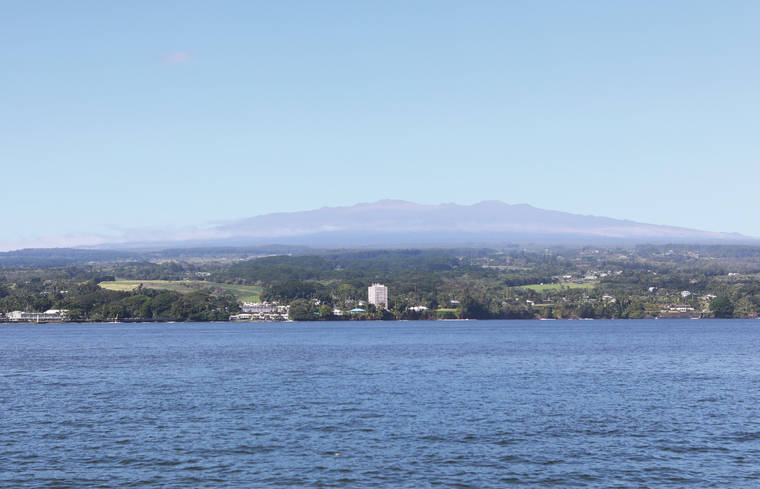
A light vog from the Kilauea eruption lingers over Hilo on Monday, Dec. 28, 2020. (KELSEY WALLING/Tribune-Herald)
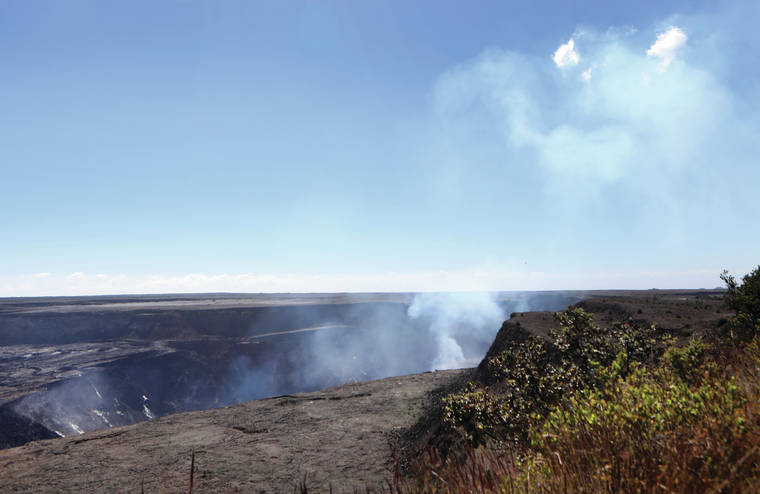
A light plume rises from Halemaʻumaʻu crater at Hawaii Volcanoes National Park in Volcano on Monday, Dec. 28, 2020. (KELSEY WALLING/Tribune-Herald)
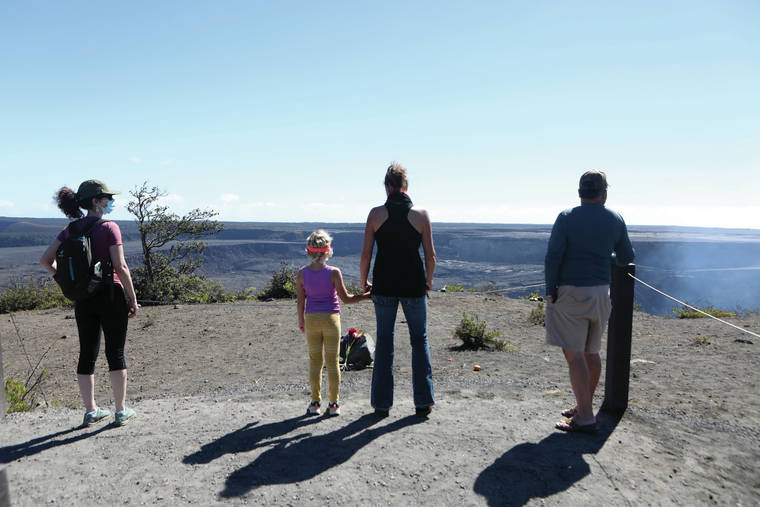
Three parties of people distance themselves to watch a plume from Halemaʻumaʻu crater at Hawaii Volcanoes National Park in Volcano on Monday, Dec. 28, 2020. (KELSEY WALLING/Tribune-Herald)
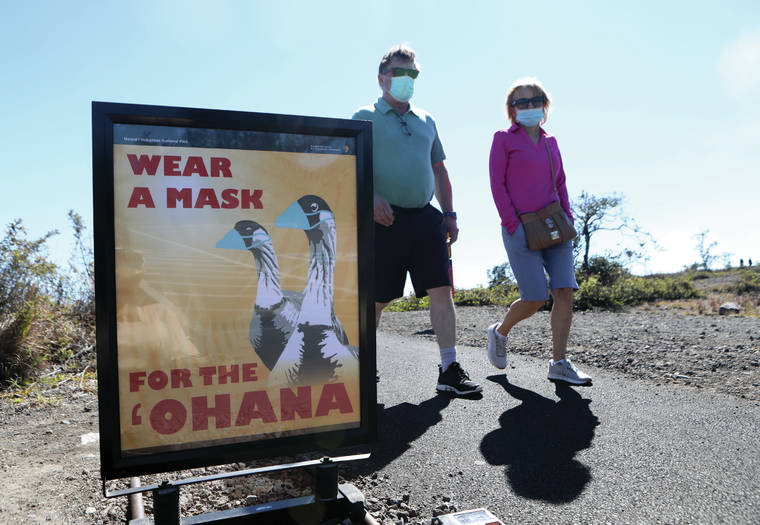
A couple walks past a sign that reminds visitors to wear masks at Kilauea Overlook at Hawaii Volcanoes National Park in Volcano on Monday, Dec. 28, 2020. (KELSEY WALLING/Tribune-Herald)
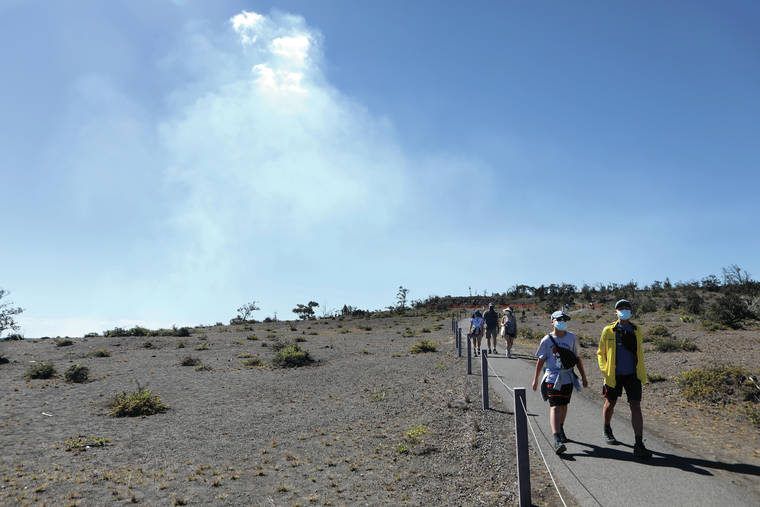
Visitors walk down Crater Rim Trail while a light plume rises in the air from Halemaʻumaʻu crater at Hawaii Volcanoes National Park in Volcano on Monday, Dec. 28, 2020. (KELSEY WALLING/Tribune-Herald)
Because of the ongoing eruption at Halema‘uma‘u crater, Hawaii Volcanoes National Park has brought in additional staff to manage an influx of visitors.
Because of the ongoing eruption at Halema‘uma‘u crater, Hawaii Volcanoes National Park has brought in additional staff to manage an influx of visitors.
The park had a sharp increase in attendance last week after lava returned to the crater for the first time since the 2018 eruption. While visitation rates are still a fraction of what they were back then, they are still a stark contrast to months of low attendance caused by the global COVID-19 pandemic.
Parks spokeswoman Jessica Ferracane said visitor statistics from last week indicated that at least 10,083 people entered the park since the eruption began, with the busiest days being Dec. 21 — the day after the eruption began — when 1,810 visitors entered the park, and the day after Christmas, when 1,759 entered.
However, she emphasized that those statistics are incomplete since they are based only on observations when the park’s entrance station is manned. The complete visitor count is likely significantly higher.
“I am going to guess that, once we get the real, full stats … it’s going to be over 20,000,” Ferracane said, noting that a substantial amount of people visiting are coming in the evenings.
Even though more people are visiting, Ferracane said there have not been significant violations of COVID-19 precautions, although she acknowledged that areas such as the Steam Vents and Kilauea Overlook become extremely crowded in the evenings.
Park rangers encourage visitors to maintain social distancing wherever possible and keep masks on when in close proximity to others.
“It just seems crowded at those specific locations, but there’s not much of a change in the rest of the park,” Ferracane said. “Just avoid the Steam Vents and overlook around 8 p.m., and it’s fine.”
With so many people visiting again, Ferracane said HVNP has brought in an incident command team as it did during the 2018 eruption and the Keauhou forest fire the same year. The team, which includes staff from other U.S. national parks, will take over management of eruption-related duties while HVNP’s normal staff can continue to do their regular work.
Among the command team’s duties will be managing the increased traffic and providing additional information to guests, such as explaining safety precautions, Ferracane said.
Ferracane said the glow from Halema‘uma‘u is less dramatic than it was during the initial days of the eruption, but still worth seeing.
A group of visitors from California already had planned to visit the park Monday before the eruption began last week. The three men sported masks and backpacks for a hike near the Kilauea Overlook.
“The timing of our trip was just a happy accident,” Chris Thompson said. “We want to see the lava, though, so maybe we’ll come back at night for the glow.”
The Hawaiian Volcano Observatory reported Sunday evening that the lava lake in the crater was 581 feet deep, containing about 4.9 billion gallons of lava.
While most of the incident command team already has commenced work, Ferracane said HVNP’s backcountry will remain closed at night for the time being. The park closed the backcountry trails during night hours last week because the amount of available staff was insufficient to adequately support both the high volume of lava watchers and visitors to the backcountry.
An upper area of the park’s Kahuku unit has also been closed pending an air quality assessment, Ferracane said.
So far, the amount of vog and volcanic fumes produced by the eruption has not posed a safety hazard at the main park — HVO observations Sunday evening measured about 5,500 tons of sulfur dioxide per day — but Ferracane added that face masks intended to prevent the spread of COVID do nothing to protect wearers from volcanic gases.
Ferracane said an update about the backcountry will be forthcoming in the next few days.


